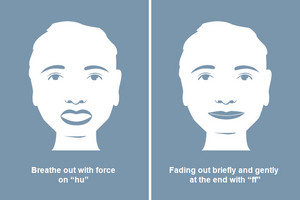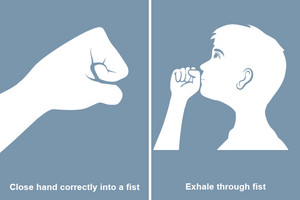Thursday, 20. April 2023
Are you plagued by a nagging cough? We have tips from a respiratory physiotherapist on how you can gently cough away a dry nagging cough and airways blocked with mucus without harming your bronchial tubes.

Coughing is a mechanism that cleans and protects the airways. There can be different reasons why we cough. People with chronic lung disease such as asthma, bronchiectasis, COPD or cystic fibrosis regularly suffer from a cough because their airways either have a build-up of mucus or are narrowed, irritated or inflamed.
The airways are irritated and have a build-up of mucus even in healthy people if they have an acute infection of the lower airways. This can happen if you catch a viral infection, such as a cold, COVID-19 or a flu-like infection. Bacteria can also cause the lungs to become inflamed and trigger a cough.
Coughing is a reflex, which is why many people simply just go for it and cough. However, a severe cough can irritate the bronchial tubes even more and can sometimes cause damage in patients with chronic lung disease. This is why it is best to avoid coughing fits. When you do cough, you should use the right technique to allow you to gently cough up mucus.

In her practice, respiratory physiotherapist Marlies Ziegler regularly works with patients who have acute or chronic problems with their lungs and a cough. She explains the right cough techniques and has tricks on how to avoid coughing.
Don’t give into your urge to cough, but instead try to take control of it. Try to huff – that puts you back in control, instead of a violent cough over which you have no control. Conscious huffing is a breathing technique.
When you do cough, try to keep it short, targeted and controlled. Breathing techniques and tips on how to control the urge to cough and to prevent coughing fits are available here.
Even if most people intuitively cough with their mouth open, it is better to cough with your lips closed. This means that the bronchial tubes do not collapse as severely or as quickly. If they collapse, it makes you want to cough even more. Also, you are more likely to lose control of a coughing fit with your mouth open and it can sometimes make you feel sick or vomit.

If your lips cannot withstand the pressure of the cough, press the back of your hand against your mouth and cough against that. Another option is to cough into a “fist funnel” (lightly closed fist). If you are out and about, depending on how mobile you are, you can cough against your elbow or arm. What is important is that your lips touch your elbow or arm while you cough. It can be helpful to slightly puff out your cheeks while you cough, no matter which of the above options you use.
Coughing against your hand, fist or arm has a similar effect to coughing with your lips closed. It also forms a slight air barrier that goes down to the bronchial tubes. The mucosal membranes do not collide with each other as much and do not collapse.
Remember to wash or disinfect your hands after you have coughed into your hand or fist.
Extra tip: You can also use the fist tunnel as a breathing technique to control the urge to cough and avoid a coughing fit.
Even if it is tempting to breathe in through your mouth as you cough, you should make a conscious effort to breathe in through your nose. Breathing through your mouth can make you want to cough even more because the air that flows in is too cold, for example, or may make you feel as if you have a dry throat. But breathing through your nose is recommended anyway, whether you have a cough or not because it is much healthier and has advantages over mouth breathing.
When you cough, it is best to adopt a posture that reduces any strain. Sit down, bend forwards and lay your arms on your thighs. If you are coughing standing up, bend forwards and support yourself with your arms on a window sill, for example, or the banister or the back of a chair. You can also adopt a different posture to make it easier to breathe, such as the “coachman position” where you sit down and lean forwards or the “goalkeeper position” where you stand, bend your knees and rest your hands on your knees. You can find instructions on postures that help you breathe more easily here.
If you have a cough that persists for several weeks (for instance due to chronic lung disease or post-covid), turn sideways slightly – about as far as when you cough into your elbow. This eases the strain on the pelvis and helps prevent pelvic weakness – coughing can lead to pelvic weakness and incontinence.
People who already have a weak pelvis should also turn sideways slightly to ease the strain on their pelvis.
A dry, unproductive cough – so a cough where you do not feel any mucus in your bronchial tubes – should be delayed as long as possible, or ideally avoided altogether. But that’s impossible, you may think? It isn’t! Tips on how to stop the urge to cough and avoid coughing fits are available here.

If you have a productive cough, i.e. if there is mucus in your bronchial tubes, coughing is good for you. But the same applies here – you should cough as little as possible. Ideally, you should only cough once the mucus is as far up as possible. There are breathing techniques and exercises that help mobilise the mucus and transport it as far as possible up through your airways without coughing.
You should avoid pain – even when you cough If you get pain deep down in your lungs or chest, you should see your doctor. You can also use home remedies and tips for a painful cough.
This article was written in cooperation with Marlies Ziegler. She works as a physiotherapist in private practice in Munich. She specialises in respiratory therapy. She has been treating patients with chronic obstructive and restrictive airway diseases such as asthma, COPD, cystic fibrosis (CF) and primary ciliary dyskinesia (PCD), for more than 20 years.
Note: The information in this blog post is not a treatment recommendation. The needs of patients vary greatly from person to person. The treatment approaches presented should be viewed only as examples. PARI recommends that patients always consult with their physician or physiotherapist first.
An article written by the PARI BLOG editorial team.
© 2024 PARI GmbH Spezialisten für effektive Inhalation